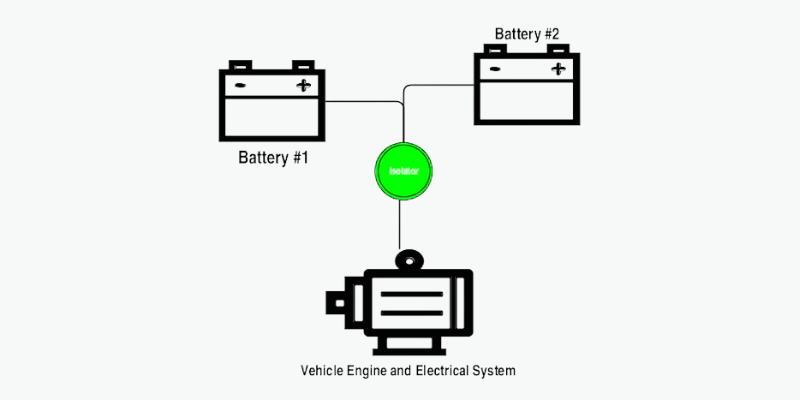Pri raziskovanju oddaljenih območij razmislite o dvojni nastavitvi baterije za zanesljivo moč v vozilih, čolnih ali RV -jih nadzemna vozila. Zanašanje samo na baterijo motorja je lahko tvegano pri uporabi elektronike. Ta članek zajema bistvene informacije o dvojnih baterijskih sistemih in nastavitvah za robustno rešitev. Začnimo!
Kaj je dvojna nastavitev baterije?
Sistem z dvojnim baterijo povezuje dve bateriji z alternatorjem vozila, kar zagotavlja zanesljivo moč za kampiranje in štirikolesna.
Odlikuje ga izolator, ki preprečuje, da bi se glavna baterija izpustila, ko je vozilo izklopljeno, in omogoča polnjenje, ko motor deluje. Prednosti vključujejo minimalno vzdrževanje, upornost vibracij in prilagodljive možnosti pritrditve baterije.

Kako deluje?
Za nastavitev dvojnega baterijskega sistema je pomembno razumeti njegovo funkcijo.
Ta sistem izboljšuje razpoložljivo napajanje vašega vozila s povezovanjem dveh baterij v seriji. Prva baterija začne motor in poganja redne operacije, druga baterija pa podpira dodatke, kot so kamp luči, prenosni računalniki in majhni hladilniki. Ta nastavitev pomaga preprečiti prekomerno uporabo zaganjalne baterije in se naseliti.
V mnogih sistemih lahko začasno "vzporedno" povežete obe bateriji, da pomagate pri zagonu, če je začetna baterija izpraznjena.
Isolator loči zaganjalnik od sekundarne baterije in tako zagotovi, da delujejo neodvisno in ohranja sposobnost za začetek vašega vozila. Z ustreznim izolatorjem lahko učinkovito napolnite in uporabljate obe bateriji.
Ali vaša čezmejna ploščad ali čoln potrebuje dvojne baterije?
Dvojna nastavitev akumulatorja v vaši ploščici ali čolnu ni bistvenega pomena, saj lahko zadostuje baterija motorja. Vendar prednosti dodatne moči odtehtajo pomanjkljivosti.
Zanašanje samo na zaganjalno baterijo omejuje njegovo uporabo, ne da bi zagnali motor, saj so zaganjalne baterije namenjene kratkim visokim tokom in hitrim polnjenjem, ne za daljše uporabe ali globoke izpuste. To lahko prepreči zagon motorja in poškoduje baterijo.
Zato dvojni baterijski sistem z litijeve baterije je pogosto priporočljivo za pretiravanje in je priljubljen na jadrnici in jahtah LiveAboard.

Korak za korakom do dvojne nastavitve sistema akumulatorja
Če nameščate dvojni akumulatorski sistem, sledite temu vodniku po korakih.
1. korak: Izberite svojo baterijo
Lahko namestite katero koli sekundarno baterijo, če obstaja prostor in možnost pritrditve. Prepričajte se, da polnilnik zagotavlja pravilno moč.
Medtem ko so baterije s svinčeno kislino pogoste, so prednostne litijeve baterije zaradi svoje globoke zmogljivosti in hitrega polnjenja. Imajo tudi višje energijska gostota, so 55% lažji in jih je mogoče namestiti v zaprte prostore, saj ne odzračujejo strupenih plinov.
2. korak: Namestite izolator
Isolator baterije usmerja polnjenje na vašo sekundarno baterijo, ne da bi tvegal vašo primarno. Nahrani tok od alternatorja do obeh baterij, kar vam omogoča, da po potrebi skočite z avtomobilom s sekundarnim.
Priključite pozitivni terminal primarne baterije s pozitivnim terminalom izolatorja in nato ustrezno priključite negativnosti. Prepričajte se, da so vse povezave varne in ozemljene; Če ne veste, se posvetujte s strokovnjakom.
3. korak: Nastavite polnjenje
Sistem z dvojnim baterijo lahko napolnite s pomočjo alternatorja vašega vozila med vožnjo ali z alternativnimi metodami, kot so sončni paneli ali generatorji, ko so zunaj omrežja.
Za večjo učinkovitost z litijevimi baterijami razmislite o polnilniku DC-to-DC, ki prilagodi tok pretoka glede na globino praznjenja; Za dodatne stroške lahko deluje tudi s sončnimi paneli. Čeprav je cenovno bolj kot izolator, znatno poveča zmogljivost vaše nastavitve.

Ali bodo dvojne baterije poškodovale moj alternator?
Povezava več baterij z alternatorjem brez ustreznega upoštevanja lahko povzroči znatno škodo, saj je večina alternatorjev zasnovana tako, da polni samo eno baterijo svinčene kisline. Prekomerno polnjenje lahko privede do pregrevanja in taljenja navitja.
Vendar je dvojna nastavitev akumulatorja varna, če je pravilno prižgana z DC do polnilnika ali polnilnika alternatorja, ki upravlja stanje naboja, vključno z napetostjo, ojačevalniki in temperaturo.
Poleg tega razmislite o dodajanju regulatorja alternatorja za boljši nadzor nad polnjenjem. Nekateri izberejo drugega alternatorja za odvečnost in zanesljivost v vozilih. Čolni z dvema motorjema pogosto polnijo ločene banke baterije od vsakega motorja; Če en alternator ne uspe, jih je mogoče ponovno opraviti, da bodo začetne baterije poganjale za varno vrnitev domov.
Ali potrebujem izolator za drugo baterijo?
Da, izolator za drugo baterijo je ključnega pomena, da vaš hišni akumulatorski sistem loči od baterije podvozja. Preprečuje, da bi okvara ali odtok ene baterije vplivala na druge, kar omogoča, da druga baterija služi kot varnostna kopija. Na podlagi vaših potreb lahko izbirate med regulatorjem polnjenja ali namenskim relejem izolatorja baterije.

